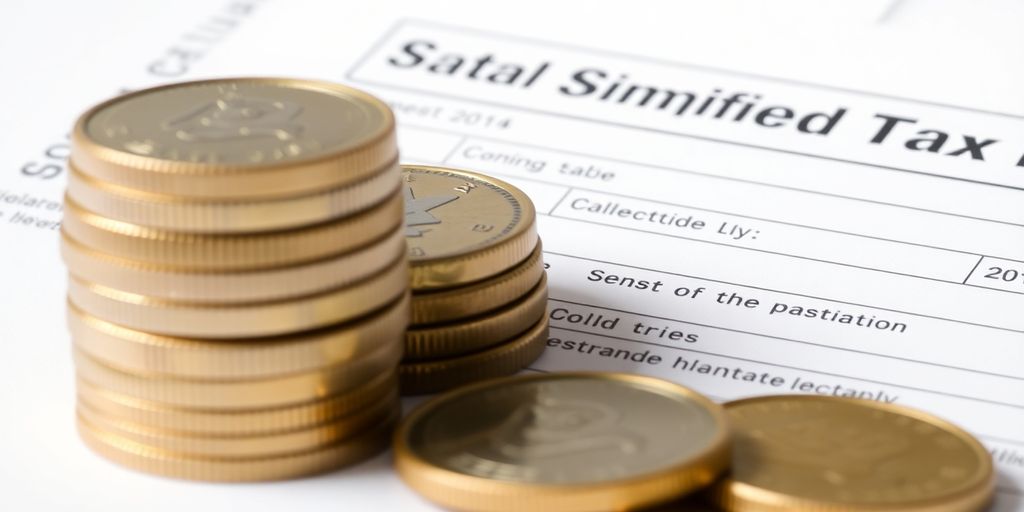Thinking about your taxes for the upcoming year can feel a bit much, right? Especially with all the talk about changes to the income tax threshold 2024. It’s not always super clear what’s happening with tax rates and how it all affects your take-home pay. We’ll break down the basics of Australia’s income tax system for 2024, looking at what you earn, what you can claim, and what other bits and pieces like the Medicare Levy might mean for you. Let’s try and make sense of it all.
Key Takeaways
- From 1 July 2024, changes to tax rates mean lower taxes for many Australians, with the lowest tax rate dropping from 19% to 16%.
- Australia uses a progressive tax system, meaning you only pay higher rates on the portion of your income that falls into a higher bracket, not on your entire income.
- Assessable income includes things like your wages, allowances, and investment income, but not all payments you receive are taxed.
- Allowable deductions can lower your taxable income, and common ones include work-related expenses. Keeping good records is important.
- Beyond income tax, you might also need to consider the Medicare Levy, which is an extra 2% on top of your income tax for most residents.
Understanding the 2024 Australian Income Tax Threshold
So, let’s talk about how much tax you’ll actually pay in Australia for the 2024-25 financial year. It’s not as complicated as it sounds, really. The government uses a progressive tax system, which basically means the more you earn, the higher the percentage of tax you pay on that extra income. The first $18,200 you earn is completely tax-free. That’s your tax-free threshold, and it’s a pretty important number to remember.
Key Changes to Tax Rates from July 2024
There have been some tweaks to the tax rates kicking in from July 1, 2024. These changes are part of a plan that’s been rolling out for a bit now. The main idea is to lower the tax burden for a lot of people. For instance, the rate for income between $18,201 and $45,000 is now 16%, down from 19%. Also, the higher income brackets have seen their thresholds adjusted upwards, meaning you’ll pay the lower rates for longer. It’s all about trying to put a bit more money back into people’s pockets.
Here’s a look at the new rates:
| Taxable Income (AUD) | Tax Rate | Tax Payable on this Income |
|---|---|---|
| $0 – $18,200 | 0% | Nil |
| $18,201 – $45,000 | 16% | 16c for each $1 over $18,200 |
| $45,001 – $135,000 | 30% | $4,288 plus 30c for each $1 over $45,000 |
| $135,001 – $190,000 | 37% | $31,288 plus 37c for each $1 over $135,000 |
| $190,001 and over | 45% | $51,638 plus 45c for each $1 over $190,000 |
Remember, these figures don’t include the Medicare Levy or any tax offsets you might be eligible for, like the Low Income Tax Offset (LITO). You can find more details on the Australian Tax Office website.
The Progressive Tax System Explained
Australia’s tax system is progressive. This means that as your income increases, the tax rate applied to the portion of your income above certain thresholds also increases. It’s designed so that those who earn more contribute a larger proportion of their income to government revenue. So, while someone earning $50,000 might pay tax at 16% and 30% on different parts of their income, someone earning $150,000 will pay tax at 16%, 30%, and 37% on different portions of their earnings. It’s a way to distribute the tax burden more evenly across different income levels.
The tax-free threshold of $18,200 is a key feature, meaning your initial earnings aren’t taxed at all. After that, the rates step up, with each higher bracket applying to the income earned within that specific range.
Impact of Tax Cuts on Your Pay
These changes mean that for many Australians, their take-home pay will increase from July 2024. For example, someone earning $60,000 will pay less tax than they did in the previous financial year. The exact amount saved depends on your income level, but the government has released tables showing these differences. It’s worth checking how these changes specifically affect your pay packet. Generally, the lower and middle income earners are seeing the most significant benefits from these adjustments.
Navigating Your Assessable Income for 2024
So, what exactly counts as income when the tax office looks at your earnings? It’s not just your regular pay cheque. Your assessable income is basically all the money you receive that the Australian Taxation Office (ATO) considers taxable. This can include a fair bit more than just your salary or wages. Think about things like interest from your bank accounts, dividends from shares, or even rent if you own an investment property. If you’ve sold an asset like shares or property for more than you paid for it, that profit, known as a capital gain, is also usually assessable.
It’s also important to remember that if you’re running a business, your business income needs to be declared. If you’re in a partnership, you declare your share of the profits. Even if you’re a beneficiary of a trust and the income stays within the trust, you still need to declare your portion. And if you earn money overseas as an Australian resident, that generally needs to be reported too, though there are systems in place to avoid double taxation.
What Constitutes Assessable Income?
Assessable income is the sum of all income you receive that is subject to tax. This includes your salary and wages, but also other forms of income like:
- Interest from savings accounts and term deposits.
- Dividends from shares or managed funds.
- Rental income from investment properties.
- Profits from selling assets (capital gains).
- Business income, including your share of partnership or trust distributions.
- Foreign income earned while being an Australian resident.
Common Income Sources for Tax Purposes
When we talk about common income sources, we’re usually referring to the money that flows into your bank account regularly. This typically includes:
- Wages and Salary: This is the most common form of income for many Australians, paid by an employer. Your employer usually withholds tax from each pay.
- Investment Income: This covers interest earned from bank accounts, dividends from shares, and distributions from managed funds. It’s important to keep records of these earnings.
- Rental Income: If you own a property and rent it out, the income you receive from tenants is assessable. You can usually claim deductions for expenses related to the rental property, too.
- Business Income: If you’re self-employed or run a business, all income generated from that business is assessable. This includes income from sole trader operations, partnerships, and trusts.
Income Not Included in Assessable Income
Not all money you receive is taxed. Some payments are specifically excluded from your assessable income. These can include:
- Lump sum payments from certain insurance policies, like for total and permanent disability.
- The tax-free portion of eligible termination payments (like redundancy packages).
- Genuine redundancy payments, up to specific limits based on your service length.
- Child support or maintenance payments received under a court order or registered agreement.
It’s good to know that while the average gross household income in Australia sits around $121,108, this figure can vary a lot depending on your circumstances. Understanding what counts towards your assessable income is the first step in figuring out your tax obligations. For more on income figures, you can check out details on average household income.
It’s really important to keep good records of all your income sources. This makes tax time a lot less stressful and helps ensure you’re not missing out on any deductions or paying more tax than you need to. The ATO gets a lot of information automatically, but it’s your responsibility to make sure everything is reported correctly.
Calculating Your Taxable Income in 2024
So, you’ve got your income, but how does the tax office actually figure out how much you owe? It all starts with something called taxable income. Think of it as your income after you’ve taken off all the bits the government says you can subtract. It’s not just your salary; it’s all the money you earn that’s subject to tax.
The Role of Allowable Deductions
Allowable deductions are basically expenses you’ve incurred that are directly related to earning your income. These can really make a difference to your final tax bill. It’s not just about having receipts; you need to be able to show the connection between the expense and how you earned your money. Things like work-related travel, uniforms, or even self-education expenses can often be claimed, but you’ve got to be careful – the rules can be a bit tricky.
Strategies to Reduce Taxable Income
There are a few ways people try to lower their taxable income. One common method is through salary sacrificing, where you arrange with your employer to pay for certain things directly from your pre-tax salary. This can include things like extra superannuation contributions or even a new car under a novated lease. It means less of your salary is taxed in the first place. Another strategy involves making sure you claim every deduction you’re entitled to. It sounds obvious, but many people miss out on legitimate claims because they don’t keep good records or aren’t aware of what they can claim. For instance, if you’re working from home, you might be able to claim a portion of your internet or electricity bills. It’s worth looking into what applies to your situation. Remember, the goal is to reduce your taxable income legally, which in turn reduces the amount of tax you have to pay. For example, if you’re looking at ways to manage your finances, understanding the average family income in Australia can give you some context for your own situation around AUD 98,000 annually.
How Salary Sacrificing Affects Your Tax
Salary sacrificing is a pretty neat way to lower your taxable income. When you salary sacrifice, you’re essentially agreeing to receive less gross salary in exchange for benefits or payments made by your employer on your behalf. These payments are usually made before tax is calculated. So, if you earn $80,000 and salary sacrifice $5,000 into your superannuation, your taxable income becomes $75,000. This means you’ll pay tax on a lower amount, potentially saving you money. However, it’s not always a straightforward win. You need to consider the benefits of having that money now versus having it in your superannuation for the long term. It’s a trade-off, and what works best depends on your personal circumstances and financial goals.
Here’s a simplified look at how it works:
- Before Salary Sacrifice: Assessable Income = $80,000. Taxable Income = $80,000.
- After Salary Sacrifice: Assessable Income = $75,000 (after sacrificing $5,000 to super). Taxable Income = $75,000.
This reduction in taxable income directly lowers the amount of tax you’ll pay, assuming you fall into a tax bracket where the reduction makes a difference. It’s a popular strategy for boosting superannuation balances while also reducing your current tax liability.
Exploring Tax Offsets and Deductions
So, we’ve talked about how much income gets taxed, but what about ways to actually lower that tax bill? That’s where tax offsets and deductions come in. They’re not the same thing, and knowing the difference can save you a bit of cash.
Distinguishing Between Offsets and Deductions
Think of deductions as things that reduce your assessable income. So, if you earn $60,000 and have $2,000 in deductions, your taxable income becomes $58,000. This means you pay tax on a smaller amount. On the other hand, tax offsets are like a direct discount on the tax you owe. So, if your tax bill is $10,000 and you have a $500 tax offset, you only pay $9,500.
Maximising Your Work-Related Expenses
This is where most people can claim something. If you’re buying things or paying for services specifically because of your job, you can usually claim a deduction. This covers a pretty wide range of stuff:
- Clothing and Laundry: You can claim for the cost of buying and cleaning specific work clothes, like uniforms or protective gear. Just wearing your regular clothes to work doesn’t count.
- Home Office Expenses: If you regularly work from home, you can claim a portion of your bills like electricity, internet, and phone, plus any equipment you buy for your home office.
- Self-Education: Courses that directly relate to your current job and help you earn more income are generally deductible. This doesn’t include study loans, though.
- Tools and Equipment: If you need specific tools or equipment for your job, you can claim a deduction for them.
Remember, you need to keep good records for any deductions you claim. The ATO might ask for proof, so keeping receipts is a good idea. You can find more details on what deductions you can claim on the ATO website.
Understanding the Low Income Tax Offset
This one’s a bit different. The Low Income Tax Offset (LITO) is a tax offset specifically for people earning lower incomes. It’s designed to reduce the tax payable for those on smaller salaries. For the 2024-25 income year, if your taxable income is $37,500 or less, you could get the maximum offset of $700. This amount gradually decreases as your income goes up, and it disappears completely if your taxable income reaches $66,667.
It’s important to remember that both deductions and offsets can significantly lower your tax liability, but they work in different ways. Deductions reduce the income that gets taxed, while offsets reduce the actual tax you owe.
Key Components Beyond Income Tax Thresholds

Beyond just the income tax thresholds themselves, there are a few other bits and pieces that can affect how much tax you actually end up paying. It’s not just about the rate applied to your earnings; other levies and how you structure your finances play a part too.
The Medicare Levy Explained
So, most Australians have to pay the Medicare Levy. It’s basically a small percentage of your income that helps fund the public health system. For the 2024-25 financial year, it’s set at 2% of your taxable income. This levy applies to most people, but there are some exemptions if you meet certain criteria, like having a specific type of private health insurance. It’s added on top of your income tax bill.
Medicare Levy Surcharge Implications
Now, if you earn above a certain amount and don’t have adequate private patient hospital cover, you might have to pay the Medicare Levy Surcharge (MLS). This is an extra charge on top of the standard Medicare Levy. The idea is to encourage people who can afford it to take out private health insurance, which in turn helps take the pressure off the public system. The thresholds for the MLS can change each year, so it’s worth keeping an eye on them if you’re in that income bracket.
Other Levies and Surcharges to Consider
While the Medicare Levy and its surcharge are the most common ones, there might be other things to be aware of depending on your situation. For instance, if you’re claiming certain government benefits or have specific types of income, there could be other rules or levies that apply. It’s always a good idea to check the Australian Taxation Office (ATO) website or chat with a tax professional if you’re unsure about any specific charges that might affect your tax return. Understanding these extra components can help you get a clearer picture of your total tax liability and avoid any surprises when you lodge your return.
Specific Considerations for 2024 Tax Filings

Taxation for Non-Residents in Australia
If you’re not an Australian resident for tax purposes, the rules are a bit different. Generally, you’re only taxed on income you earn from Australian sources. This includes things like salary and wages from working in Australia, or income from investments located here. It’s important to know that Australia has tax treaties with many countries, which can prevent you from being taxed twice on the same income. You’ll need to check if your home country has a treaty with Australia and understand how it applies to your situation. The Australian Taxation Office (ATO) has specific guidelines for non-residents, so it’s worth looking those up to make sure you’re meeting all your obligations. Understanding your residency status is the first step to figuring out your Australian tax.
Special Rates for Working Holiday Makers
If you’re in Australia on a working holiday visa, you might be subject to special tax rates. From 1 July 2017, working holiday makers are generally taxed at the same rates as Australian residents, but with a few key differences. For example, the tax-free threshold of $18,200 doesn’t apply to you. Instead, you’re taxed from the first dollar you earn. The rates are 15% for every dollar up to $45,000, and then the standard marginal rates apply for income above that. It’s also important to remember that you can’t claim the Low Income Tax Offset (LITO) or the Low and Middle Income Tax Offset (LMITO). You’ll need to make sure your employer has your correct visa details to ensure you’re taxed correctly. You can find more details on the ATO website.
Taxation of Minors and Unearned Income
When it comes to kids earning money, things get a bit more complex. If a child under 18 earns income from a job, it’s taxed like anyone else’s, but there are special rules for ‘unearned’ income. This is income that doesn’t come from their own work, like interest from a savings account or distributions from a family trust. For unearned income, the first $416 is tax-free. After that, the next $3,754 is taxed at a flat rate of 66%. Any unearned income above $4,170 is then taxed at the adult marginal tax rates. This is designed to stop people from shifting income to children to avoid higher adult tax rates. So, if you’re managing finances for a minor, it’s good to be aware of these specific rules.
Wrapping Up: What to Remember About Your Tax
So, that’s a look at how Australia’s income tax system is set up for this year. We’ve seen how the tax-free threshold works and how different income levels are taxed. Remember, the first $18,200 you earn is generally tax-free, and then the rates go up from there. It’s also good to know about things like tax offsets and deductions, because they can actually lower the amount of tax you owe. Keep an eye on those changes coming in future years too, as they might affect your situation. It’s always a good idea to check the ATO website or chat with a tax pro if you’re unsure about anything specific to your income.
Frequently Asked Questions
What’s the tax-free threshold in Australia?
The tax-free threshold is the amount of money you can earn in a financial year before you have to pay any income tax. For most Aussies, this is $18,200. So, the first $18,200 you earn is safe from tax, but anything above that gets taxed.
How does Australia’s tax system work?
Australia uses a progressive tax system. This means that as you earn more money, you pay a higher percentage of tax, but only on the extra money you earn. It’s not like your whole pay packet gets hit with the highest rate you reach; only the bits of income that fall into those higher tax brackets are taxed at those higher rates.
What counts as assessable income?
Your assessable income is basically all the money you earn that the tax office wants to know about. This includes your wages from a job, money from investments like shares or rental properties, and even some allowances from your employer. It’s everything you need to declare on your tax return.
What are tax deductions and how do they help?
Tax deductions are expenses you can claim that reduce your assessable income, meaning you pay less tax. Things like work-related costs (uniforms, tools, training), donations to charity, or costs for managing your tax affairs can often be claimed. It’s always a good idea to keep records of these expenses!
What’s the difference between a tax offset and a tax deduction?
A tax offset is different from a deduction because it directly lowers the amount of tax you actually have to pay, rather than just reducing your taxable income. The Low Income Tax Offset (LITO) is an example that helps people on lower incomes pay less tax.
What is the Medicare Levy?
The Medicare Levy is a small extra tax (usually 2%) that most Australians pay. It helps fund Australia’s public health system, Medicare. Some people might have to pay a Medicare Levy Surcharge if they earn over a certain amount and don’t have private health insurance.





